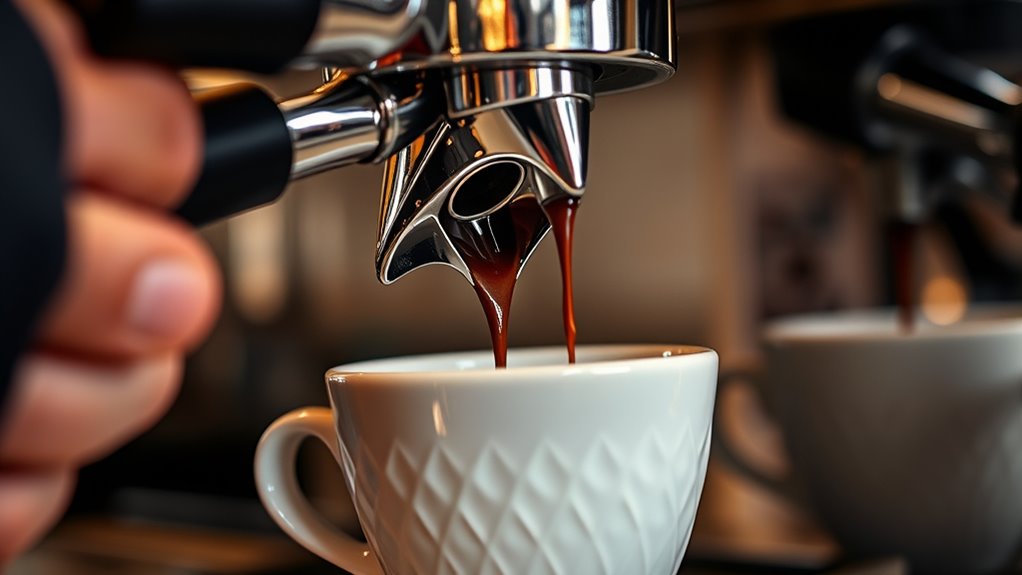To fix espresso channeling, start by evenly distributing your coffee grounds in the portafilter, then tap or shake gently to settle them uniformly. Use a consistent grind size and focus on a flat, even tamp to prevent thin spots. Adjust your machine’s pressure and temperature for ideal flow. Regular cleaning and maintenance help prevent blockages. Mastering these techniques ensures better extraction—stay tuned for more tips to perfect your espresso craft.
Key Takeaways
- Evenly distribute and tamp grounds to prevent thin spots that cause rapid water flow and channeling.
- Use consistent grind size and proper bed preparation to ensure uniform water flow and extraction.
- Regularly clean and maintain your espresso machine to avoid blockages and uneven water distribution.
- Adjust machine pressure and temperature settings incrementally for optimal extraction and reduced channeling.
- Identify and correct signs of channeling—such as spurting or thin crema—by redistributing grounds and refining technique.
Understanding the Causes of Channeling in Espresso
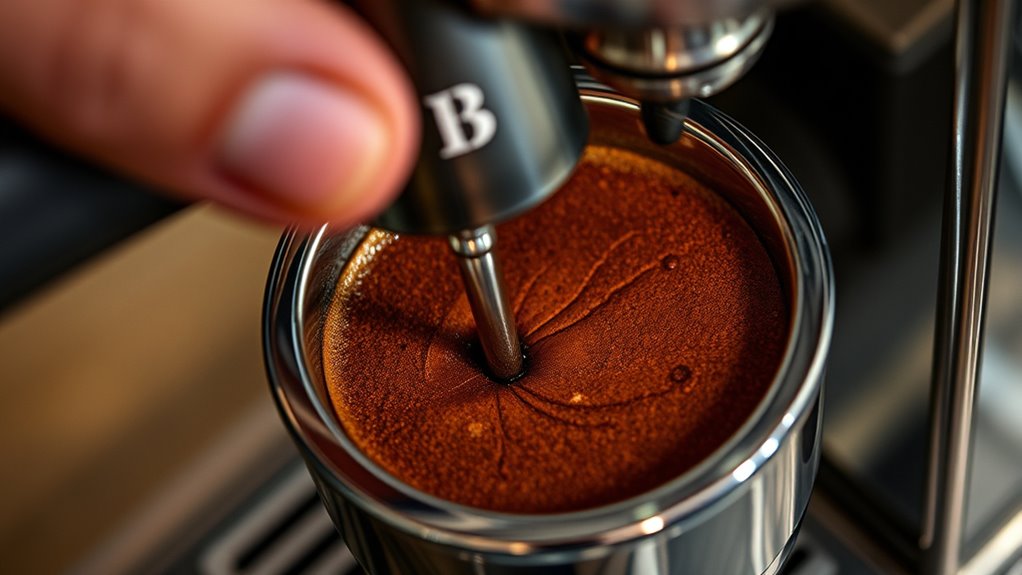
Have you ever wondered why your espresso sometimes tastes weak or uneven? Channeling often occurs when water finds an easy path through the coffee puck, leading to uneven extraction. One key factor is coffee bean freshness; stale beans can create uneven grounds that promote channeling. Fresh beans, on the other hand, ensure uniform grind size and density, reducing gaps where water can escape. Water mineral content also plays a role—water that’s too soft or too hard can affect extraction pressure and flow, encouraging channeling. Poor distribution of coffee grounds or inconsistent tamping can worsen this issue, but even with proper technique, the quality of your coffee and water matter. Understanding these causes helps you troubleshoot and tweak your setup for a more balanced, flavorful shot.
The Importance of Proper Dose Distribution and Tamping
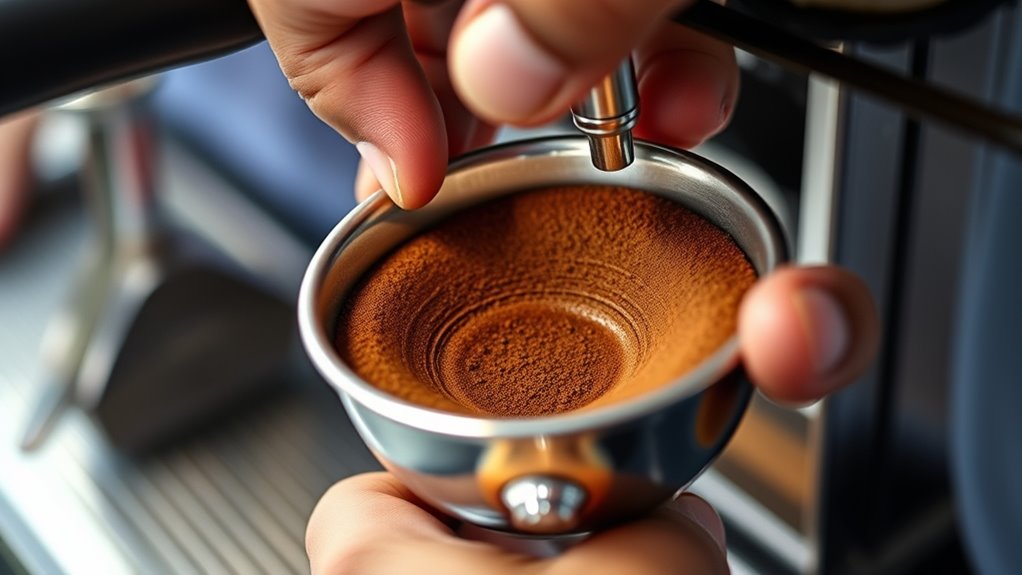
Proper dose distribution and tamping are crucial steps in preventing channeling and ensuring an even extraction. When you distribute coffee beans evenly, you avoid thin spots that cause water to flow too quickly, leading to uneven extraction. Different coffee bean varieties can impact how well they pack, so pay attention to their density and grind size. After dosing, tamp firmly and evenly, creating a flat, consistent surface that resists water bypass. Water mineral content also plays a role; softer water interacts better with the coffee grounds, promoting uniform extraction. Proper tamping ensures consistent pressure across the puck, reducing the chances of water finding shortcuts. Additionally, understanding the material properties of your coffee grounds can help optimize packing density and tamping technique. Mastering dose distribution and tamping is key to achieving a balanced shot and avoiding those frustrating channeling issues.
How Grind Size and Consistency Affect Channeling
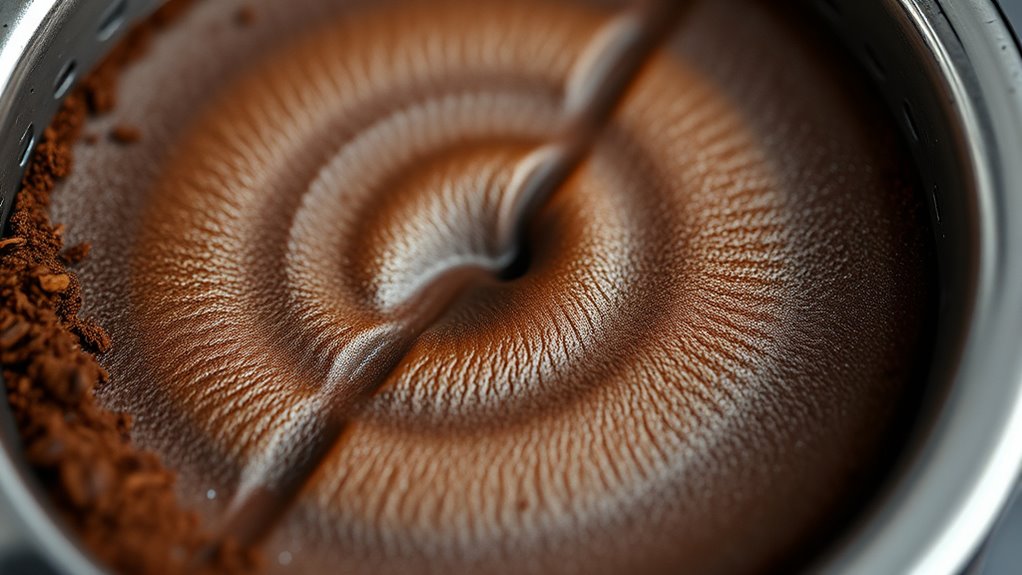
Grind size and consistency directly influence how water flows through your coffee puck, making them critical factors in preventing channeling. If your grind is too coarse, water passes quickly through the coffee, causing uneven extraction and potential channeling. Conversely, a grind that’s too fine increases resistance, which can lead to over-extraction and uneven flow. Consistency in grind size ensures uniform particle size, promoting even water distribution and reducing the risk of water finding paths of least resistance. Irregular grind sizes create gaps and channels that allow water to bypass coffee grounds, resulting in under-extracted shots. By maintaining the right grind size and consistent particle size, you help guarantee water flows evenly through the puck, minimizing channeling and extracting the best flavors from your espresso.
Techniques for Even Coffee Bed Preparation
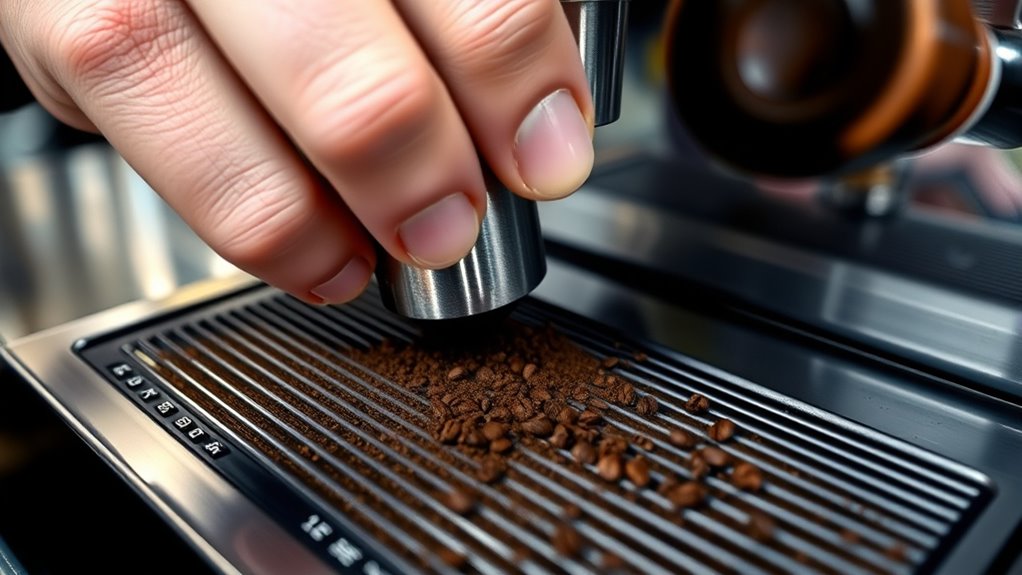
To guarantee an even coffee bed, start by distributing the coffee grounds evenly in the portafilter. Gently tap or shake it to settle the grounds uniformly, reducing the risk of channeling. Proper coffee bean storage ensures your grounds stay fresh and consistent, which helps achieve even extraction. When preparing your espresso, focus on evenly spreading the grounds before tamping firmly. This creates a uniform surface, essential for channeling prevention. Additionally, mastering milk frothing techniques can improve your overall espresso quality, as well-frothed milk complements a well-prepared shot. Consistent preparation practices, including proper storage and handling of coffee beans, contribute to a stable bed that resists uneven water flow. Being mindful of coffee quality can also make a significant difference in achieving a balanced extraction. With these techniques, you’ll produce more balanced, flavorful espresso shots every time.
Adjusting Your Machine’s Pressure and Temperature Settings
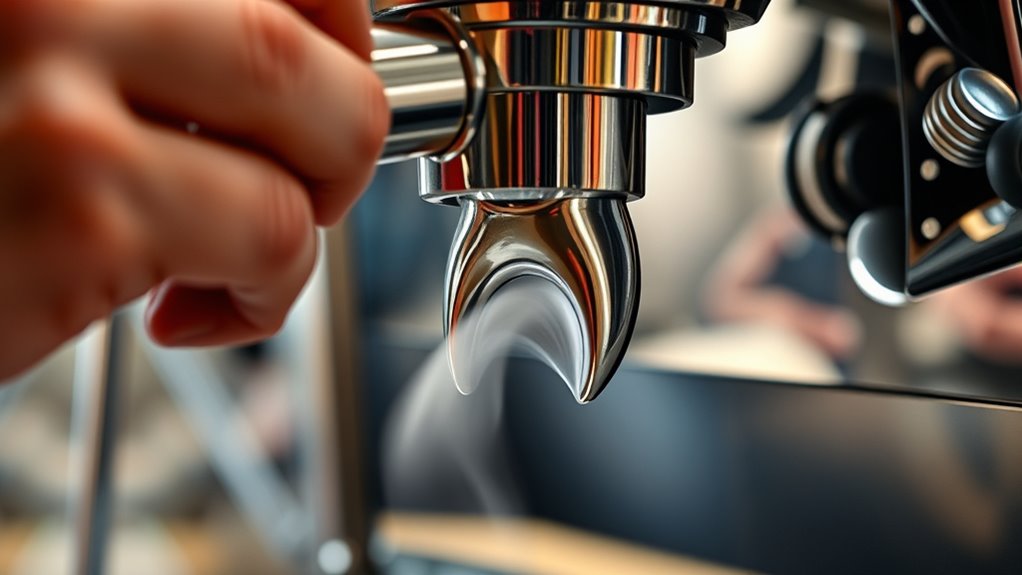
To improve your espresso, start by fine-tuning the pressure levels on your machine; the right pressure helps prevent channeling. Next, focus on optimizing the brew temperature to guarantee your coffee extracts fully and flavors develop properly. Small adjustments here can make a big difference in your shot quality.
Fine-Tuning Pressure Levels
Adjusting your espresso machine’s pressure and temperature settings is essential for achieving the perfect shot. Fine-tuning pressure regulation helps you control the force forcing water through the coffee, directly impacting espresso consistency. If pressure is too high, your shot may taste bitter or over-extracted; too low, and it’ll be weak or under-extracted. Start by adjusting the pressure gauge or machine settings incrementally. Keep notes of each change to understand its effect. Consistent pressure ensures your espresso has the right body and flavor profile. Remember, small adjustments make a big difference. Regularly check and calibrate your machine’s pressure levels to maintain ideal extraction conditions. This precision will improve your overall espresso quality and keep your brewing process predictable. Incorporating knowledge of proper temperature control can further refine your espresso results.
Optimizing Brew Temperature
Optimizing brew temperature is essential for extracting the full flavor potential of your espresso. Maintaining temperature stability throughout the brew cycle ensures consistent extraction, preventing under- or over-extraction. Start by adjusting your machine’s temperature settings to match the beans’ ideal range, typically between 195°F and 205°F. Keep an eye on temperature fluctuations, as instability can cause channeling or weak crema. Use a thermometer or built-in gauges to monitor the brew cycle, making small adjustments as needed. Consistent temperature helps dissolve the correct amount of solubles, enhancing flavor clarity and body. Remember, even slight temperature deviations can impact espresso quality, so fine-tuning your machine’s settings is key to achieving a balanced, flavorful shot every time. Additionally, understanding how environmental considerations like ambient temperature and humidity can influence brew temperature will help you maintain optimal conditions for a perfect espresso.
Using Distribution Tools to Achieve Uniformity
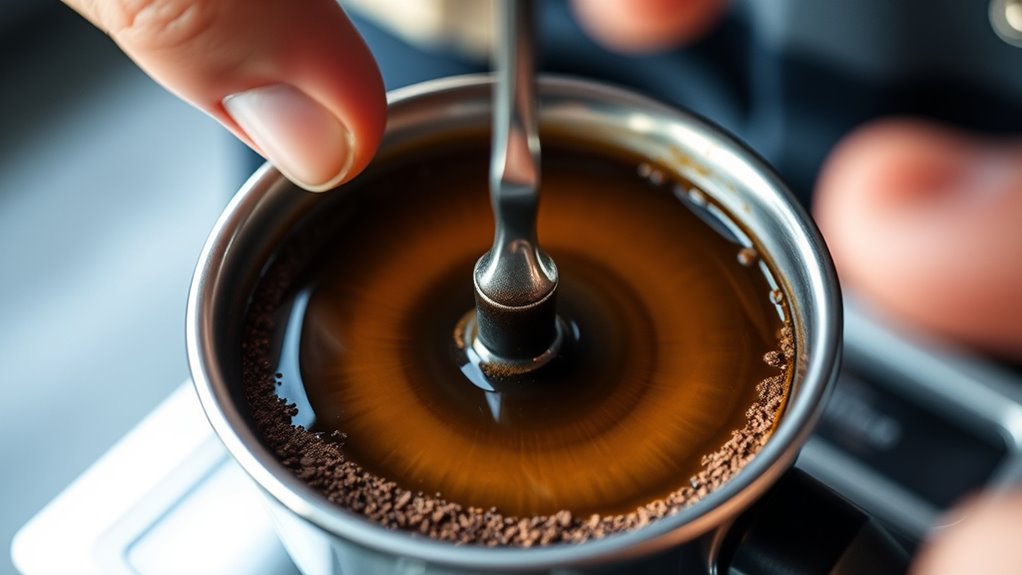
Using distribution tools is essential for guaranteeing your coffee grounds are evenly spread in the portafilter, which directly impacts channeling and extraction quality. Proper distribution prevents uneven water flow, leading to a more consistent shot. Before using tools, ensure your coffee storage is airtight to maintain freshness, as stale beans can affect grind consistency. After dosing, apply the distribution tool to level and evenly distribute the grounds, reducing the risk of uneven density. This step is vital for ideal espresso machine calibration, ensuring pressure and temperature are effective. Consistent distribution minimizes channeling, resulting in better flavor extraction. Additionally, airtight storage helps preserve bean quality, ensuring optimal grind and extraction. Incorporate a distribution technique into your routine to improve shot quality and avoid uneven brewing caused by poor grounds placement.
Recognizing and Correcting Signs of Channeling During Extraction
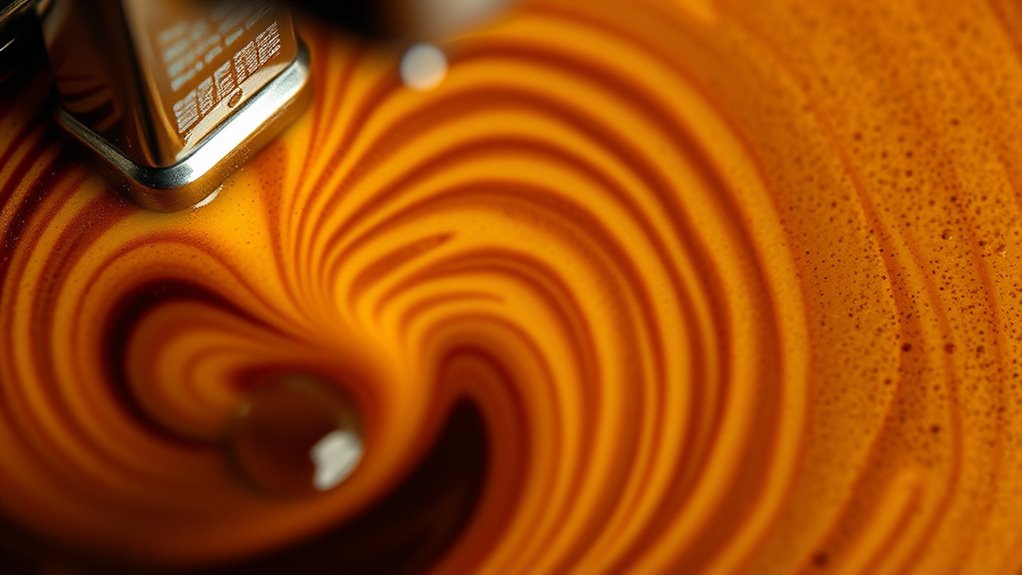
You’ll notice uneven espresso flow or visual streaks on the surface, which are clear signs of channeling. These indicators mean water is bypassing parts of the puck, leading to inconsistent extraction. To fix this, adjust your grind size or tamp pressure to promote uniform extraction patterns. Proper tamping and grind consistency are crucial for preventing channeling and achieving a balanced shot.
Uneven Espresso Flow
Uneven espresso flow often signals that channeling is occurring during extraction, which can lead to inconsistent flavors and weak spots in your shot. Recognizing these signs helps you improve your coffee flavor and refine your barista techniques. Adjusting grind size and tamping pressure can significantly reduce the chances of channeling, ensuring a more uniform extraction. Here are key indicators to watch for: 1. Rapid or uneven flow rate** — if the espresso drips inconsistently or spurts, it’s a sign of uneven flow. 2. Different flow speeds across the puck — some parts drain faster, indicating channeling. 3. Taste inconsistencies** — sour or bitter flavors suggest uneven extraction caused by flow issues. Addressing these signs involves adjusting grind size, tamping pressure, or distribution techniques. Mastering these barista techniques ensures a more consistent flow, resulting in a richer, more balanced espresso shot.
Visual Indicators of Channeling
Recognizing channeling during extraction hinges on spotting visual cues that reveal uneven flow through the coffee puck. Look for inconsistent distribution of the espresso’s flow, which creates distinctive channeling patterns. These patterns often appear as thin, light streaks or lines on the surface of the puck, indicating where water bypasses the coffee grounds. You might also see uneven discoloration or areas where the crema is thin or absent. Additionally, rapid or uneven flow during extraction can be a sign of underlying channeling. Being attentive to these visual cues helps you identify when channeling occurs, allowing you to take steps to adjust your grind size, tamping pressure, or distribution technique to promote a more uniform extraction. Visual indicators of channeling are crucial for diagnosing and correcting this issue, ultimately improving espresso quality.
Correcting Extraction Patterns
When you notice signs of channeling during extraction, it’s essential to act quickly to correct the pattern and guarantee a more even brew. Ignoring it can lead to uneven extraction, affecting flavor and latte art quality. Here are three ways to fix extraction issues:
- Adjust Grind Size – Finer grinds promote more uniform water flow, reducing channeling.
- Distribute Coffee Evenly – Use a distribution tool or tap the portafilter gently to eliminate uneven coffee bed.
- Check Coffee Storage – Properly stored coffee ensures freshness, reducing the risk of inconsistent extraction and channeling.
- Additionally, understanding the importance of contrast ratio in projectors can help you select equipment that produces clearer, more detailed images, which is essential for a satisfying home brewing or viewing experience.
Regular Maintenance and Cleaning to Prevent Channeling
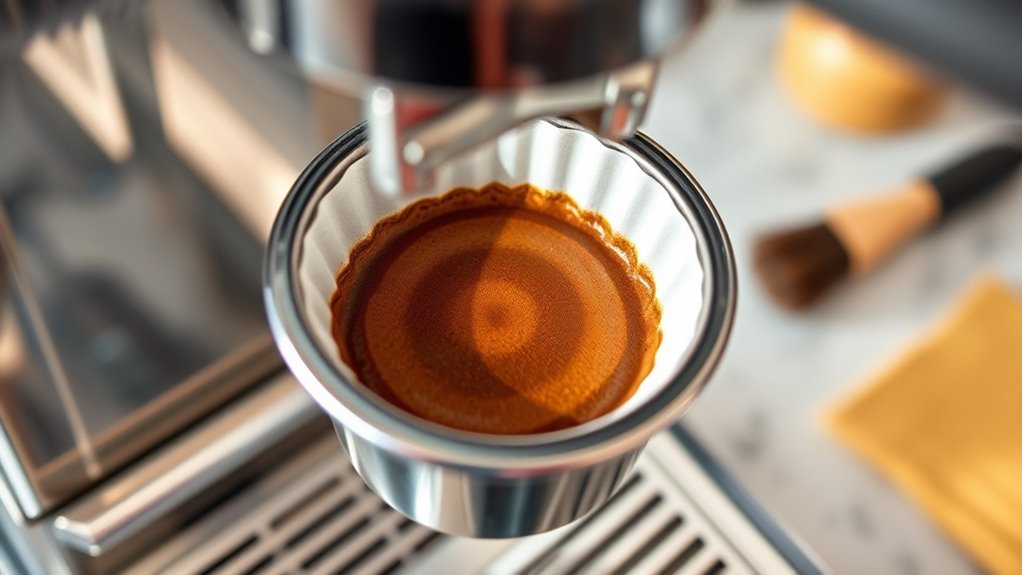
Regular maintenance and cleaning are essential steps to prevent channeling during espresso extraction. When your equipment stays clean, water flows evenly through the coffee grounds, resulting in better extraction and richer coffee flavor. Dirty parts, old oils, or residual coffee can create uneven surfaces that promote channeling. Regularly cleaning your espresso machine, grinder, and portafilter helps maintain consistent results. Proper barista training emphasizes the importance of these routines, ensuring you’re aware of how cleanliness impacts shot quality. Additionally, inspecting and replacing worn parts keeps water paths unobstructed. Lifespan perspective also highlights that consistent maintenance extends the longevity of your equipment. By staying diligent with maintenance, you minimize the risk of channeling, maximize extraction, and serve consistently delicious espresso. Clean equipment isn’t just about hygiene—it’s a key factor in achieving ideal flavor and perfecting your craft.
Experimenting With Brew Ratios and Timing for Optimal Results

Experimenting with brew ratios and timing allows you to fine-tune your espresso to match your taste preferences and equipment. By adjusting the coffee-to-water ratio, you can enhance flavor clarity or richness, considering factors like coffee bean origin. Timing also impacts extraction; shorter pulls highlight brightness, while longer ones deepen body. Keep these tips in mind:
- Vary brew ratios based on coffee origin to emphasize unique flavor notes.
- Adjust extraction time to balance acidity and bitterness, considering your water mineral content.
- Record each change to identify what produces the best shot for your setup.
Understanding how water mineral content influences extraction helps in dialing in the perfect timing. Experimentation is key—small tweaks lead to significant improvements.
Frequently Asked Questions
Can Different Bean Roasts Influence Channeling Tendencies?
Yes, different bean roasts can influence channeling tendencies. Darker roasts often require a different grind setting due to changes in bean density and oil presence, affecting grind consistency. Fresher beans tend to produce more uniform grounds, reducing channeling issues. You should experiment with your roast levels and grind size, ensuring beans are fresh and ground evenly, to prevent channeling and achieve a better espresso extraction.
How Does Ambient Humidity Affect Espresso Channeling?
Ambient humidity considerably affects espresso channeling by altering the coffee grounds’ moisture content. Higher humidity can cause grounds to clump and become uneven, increasing the risk of channeling due to inconsistent tamping. Conversely, low humidity dries out grounds, making them brittle and harder to tamp evenly. You should monitor humidity effects closely, adjusting grind size or dosing to maintain consistent extraction and prevent channeling caused by ambient influence.
Are There Specific Tamping Tools That Prevent Channeling?
Tamping tools tailored for tight, tidy tamping can help prevent channeling. You’ll want a tamper with a flat, stable base that encourages even pressure, promoting perfect tamping technique and consistent grind size. Look for tools with ergonomic handles for better grip and control. When you practice proper tamping technique and maintain grind consistency, these tools work together to minimize channeling, ensuring a smoother, more flavorful espresso shot every time.
Can Water Quality Impact Espresso Extraction and Channeling?
Yes, water quality can impact your espresso extraction and channeling. Mineralization affects how well water interacts with coffee grounds, influencing extraction consistency. Low mineral content may cause under-extraction, while too high can cause over-extraction or clogging. Additionally, water with improper brewing temperature hampers proper extraction, increasing the risk of channeling. Using filtered water with balanced mineralization and maintaining ideal brewing temperature helps guarantee even extraction and reduces channeling.
What Role Does Machine Age Play in Channeling Issues?
You might notice that an older machine can contribute to channeling issues because its durability declines over time, affecting water flow and pressure consistency. Regular maintenance becomes essential to keep components clean and functioning properly. Neglecting maintenance or using a machine past its prime can cause uneven extraction, leading to channeling. Stay proactive with upkeep to guarantee your espresso remains smooth and balanced, regardless of your machine’s age.
Conclusion
Think of your espresso basket as a tiny garden bed. When you plant seeds unevenly or neglect to water it properly, growth becomes uneven and patchy. But with careful planting, consistent watering, and tending, your garden flourishes. Similarly, by mastering channeling techniques and maintaining your machine, you guarantee your espresso garden blooms with rich, balanced flavor every time. Keep tending your skills, and your perfect shot will become your daily harvest.
